Chasing the Jules Verne Trophy
Published on March 4th, 2023
Although Gitana Team is extending its stand-by period, the Spindrift Racing team recently announced that, after four months of fruitless waiting, it is giving up on tackling the Jules Verne Trophy for this season. Update from Tip & Shaft:
Never has the crewed round the world record which has been set by Francis Joyon since 2017 been held for so long. The actual magnitude of the feat of Idec Sport and now also the difficulty in finding a properly favorable weather pattern partially explain why the Jules Verne Trophy remains so elusive.
On March 1, the end of stand-by was announced by the Spindrift Racing team, which gave up setting out on Sails of Change, led by Yann Guichard, to attack the world record. Maxi Edmond de Rothschild (Charles Caudrelier) continues to hold on on standby for some more days, but time is running out because the Jules Verne can no longer be attempted once the austral summer is over, the conditions in the South Seas then become just too tough and dangerous. “
“We are extending stand by for the meantime to give ourselves every possible chance, even if the North Atlantic is still not good”, confirms Cyril Dardashti, general manager of Gitana Team.
And so one thing is clear, again this winter – 2022-2023 – has not been favorable for a start to a Jules Verne Trophy. The Sails of Change crew believed it possible twice, meeting in Brest on both occasions, but possible weather windows on January 14 and 26 finally closed. “We really hesitated to leave, we watched the weather forecast until the final minutes, our boots were already on our feet and actually decision not to leave is more difficult to make than that to leave,” says Yann Guichard.
These two windows were also considered by Charles Caudrelier and his five crew members who, on February 12, saw another one and the Maxi Edmond de Rothschild did set off, before turning around a few hours later due to damage to part of their generator.
“Francis has set the bar very high”
But actually, a winter without the crewed round the world record being broken is nothing new. In fact Idec Sport (Francis Joyon) has held it for six years now (40 days 23 hours 30 minutes), and indeed the previous reference mark of Maxi Banque Populaire V (Loïck Peyron) dated back to January 2012 (45 days and 13 hours) – now making Joyon the longest holder in the history of the Jules Verne Trophy.
Since the record was set six attempts have been made, including those of Spindrift 2 which dismasted before crossing the start line in January 2018 and the Maxi Edmond de Rothschild this year. None passed the halfway point, the longest, to their credit, being Sodebo Ultim 3 which gave up on day 17 in December 2020.
So how do we explain how this record has become inaccessible for the meantime? “The probability of beating it is getting lower and lower, firstly because Joyon has set the bar very high”, states meteorologist Christian Dumard simply. “What has changed is that Francis (Joyon) and Loïck (Peyron) were going for 47-day records and now it is so much more difficult to go for 40 days”, adds Benjamin Schwartz, navigator aboard Sails of Change.
Other elements that come into play, an almost certainty of not being able to benefit from near perfect conditions such as were encountered by Idec Sport in the Indian Ocean “That means more than 5 days at 37 knots”, specifies Cyril Dardashti – but also the presence of icebergs drifting further north in the Southern Ocean.
This is a scenario which “forces the route to be extended”, according to Yann Guichard, and which “varies a lot from one year to another”, specifies Jean-Yves Bernot, the router of the former Spindrift 2.
“Succeeding from the get go”
Recall that Idec Sport passed the Cape of Good Hope in 12 days and 19 hours and so typically Sails of Change would go hoping for a time “below the 12-day mark” (Yann Guichard), Gitana Team looking to “at least 24 hours head of that” (Cyril Dardashti). “That would not be neither exceptional, nor unrealistic, nor absurd”, maintains Benjamin Schwartz who recalls that during its 2021 attempt the Maxi Edmond de Rothschild did better than Idec Sport (11 days 9 hours 53 minutes).
“You have to succeed on this initial ‘launch sequence’, this opening stage between the North and South Atlantic, otherwise you have almost no chance of breaking the record,” Charles Caudrelier said. “If we are behind after 10 days, we will never be able to beat him after that”. And the probability of having a good time at Good Hope is very low.
The key weather components to achieve this? A well-positioned Saint Helena anticyclone and the genesis of a depression off Brazil to be able to ride ahead of to charge towards South Africa. Once again in recent months these conditions have not been shaped up as needed. “The North Atlantic was weird this year,” says Jean-Yves Bernot. “The trade wind was weak, badly set up and we rarely had favorable conditions to be fast until at the equator.”
Christian Dumard adds, “Even if studies are currently being carried out in this area, we cannot really say there has been a definitive change in the weather in recent years. On the other hand, as the forecasting models get more accurate and look further ahead the window can be evaluated further ahead in time.” He wonders: “When you have too much weather modeling looking accurately into the long term, you end up not leaving. Maybe the teams are too greedy and not risking enough.”
Are the teams not prepared to risk now? “Setting off for a record is inherently daring,” responds Cyril Dardashti. “It is normal to rely on these advances in log term forecasting that gives us more visibility.” And the managing director of Gitana Team compared it with the North Atlantic record, held since 2009 by the Maxi Banque Populaire V (Pascal Bidégorry) in 3 days, 15 hours and 25 minutes, in 2009): “Nobody stick to it because it would require a window of madness.”
“We are right not to leave”
“We are not overly cautious. The reality is that we were right not to leave,” replies Benjamin Schwartz, while Philippe Legros, in charge of routing Sodebo Ultim 3 (which did not tackle Jules Verne this winter), adds: “Perhaps we should make several attempts, allow ourselves to star, even if it means turning around after two or three days to hang on to the weather systems.
“We should ask ourselves the question, despite the risk of breakage and the time involved.” This question, Yann Guichard admits having asked it, “We hesitated to leave even if it means turning around, but the problem is that it mobilizes you for 10 to 15 days and during that period you can miss a window.”
And in money terms a long stand-by also has a financial cost. At Spindrift Racing, each team member benefits from a retainer to remain 100% mobilized for the team. “We are paid because we can be mobilized permanently, it’s like a 24-hour on-call duty for 4 months”, confirms Benjamin Schwartz. “Everyone must be operational within 48 hours, adds Cyril Dardashti. And if the remuneration is not equivalent to that at sea, they are of course paid.”
But that is not enough to compensate for the frustration in the event of no starting. “When you see the time, the human and financial resources invested, and also our motivation – because above all we are competitors – it’s always a wet blanket of disappointment not to leave”, recognizes Schwartz. “We have been fighting for this record for 10 years, adds Yann Guichard. “We live through hard times, we run the gamut of all the emotions, but we know that if we get there one day, when we see all the efforts and the work done so far, the pleasure will be even greater.”
The rules for the Jules Verne Trophy are simple – it is for the fastest time around the world by any type of yacht with no restrictions on the size of the crew, starting and finishing from the exact line between the Le Créac’h Lighthouse off the tip of Brittany and the Lizard Point in Cornwall. It was first won in 1993, with all nine winners as either catamarans or trimarans. The current challenge is to beat the record time of 40 days 23 hours 30 minutes and 30 seconds set by Francis Joyon and crew on the 31.5m IDEC Sport in 2017.
Record Facts
• Start and finish: a line between Créac’h lighthouse (Isle of Ushant) and Lizard Point (England)
• Course: non-stop around-the-world tour racing without outside assistance via the three Capes (Good Hope, Leeuwin and Horn)
• Minimum distance: 21,600 nautical miles (40,000 kilometres)
• Ratification: World Sailing Speed Record Council, www.sailspeedrecords.com
• Time to beat: 40 days, 23 hours, 30 minutes and 30 seconds
• Average speed: 21.96 knots
• Date of current record: January 2017
• Holder: IDEC SPORT, Francis Joyon and a 5-man crew
Split Time References – Full Crew:
Ushant-Equator: 4d 20h 07 ‘(Spindrift 2 in 2019)
Equator-Cape Aiguilles: 6d 08h 55 ‘(Banque Populaire V in 2012)
Cape Aiguilles-Cape Leeuwin: 4d 09h 32 ‘(IDEC Sport in 2017)
Cape Leuuwin-Cape Horn: 9d 08h 46 ‘(IDEC Sport in 2017)
Cape Horn-Equator: 7d 04h 27 ‘(Banque Populaire V in 2012)
Equator-Ushant: 5d 19h 21 ‘(IDEC Sport in 2017)
Here are the nine that have held the trophy:
2017 – Francis Joyon / IDEC SPORT (31.5m) – 40:23:30:30
2012 – Loïck Peyron / Banque Populaire V (40m) – 45:13:42:53
2010 – Franck Cammas / Groupama 3 (31.5m) – 48:07:44:52
2005 – Bruno Peyron / Orange II (36.8m) – 50:16:20:04
2004 – Olivier De Kersauson / Geronimo (33.8m) – 63:13:59:46
2002 – Bruno Peyron / Orange (32.8m) – 64:08:37:24
1997 – Olivier De Kersauson / Sport-Elec (27.3m) – 71:14:22:08
1994 – Peter Blake, Robin Knox-Johnston / Enza New Zealand (28m) – 74:22:17:22
1993 – Bruno Peyron / Commodore Explorer (28m) – 79:06:15:56


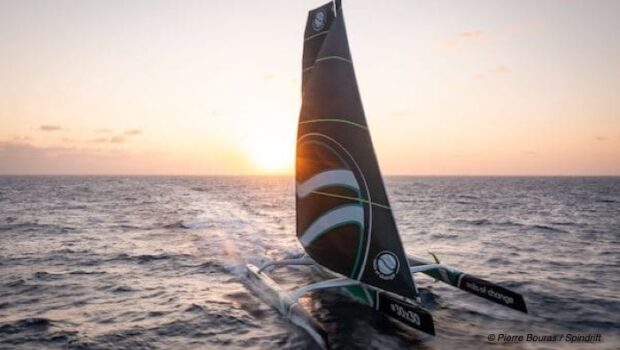


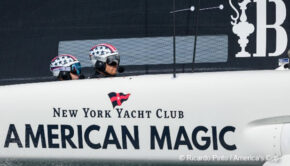
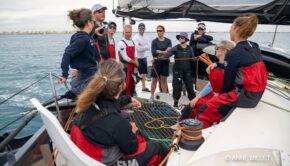
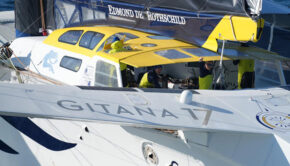
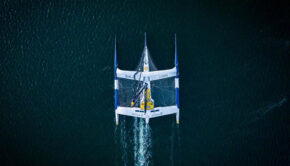
 We’ll keep your information safe.
We’ll keep your information safe.